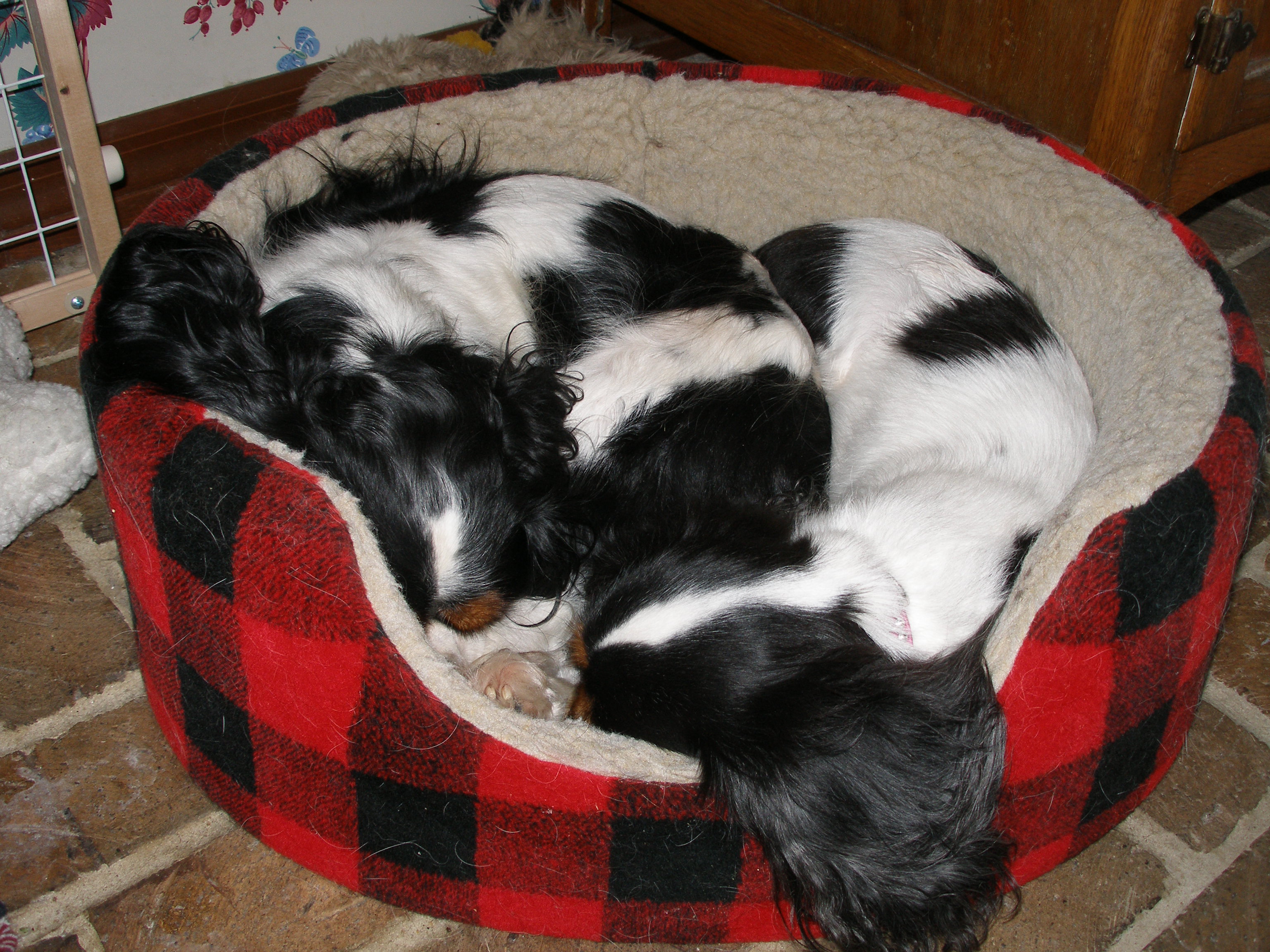The 2006 North Carolina State University Reports on Caudal
Foss
and Cerebrospinal Fluid Flow in Cavalier King Charles Spaniels
Courtesy of Dr. Sofia Cerda-Gonzalez
Neurology Clinical Studies, College of Veterinary Medicine, NCSU
MORPHOLOGY OF THE CAUDAL FOSSA IN CAVALIER KING CHARLES SPANIELS. S Cerda-Gonzalez*, NJ Olby*, TP Pease*,S McCullough†, N Massoud†, R Broadstone† *North Carolina State University, Raleigh, NC; †IAMS Pet Imaging Center, Raleigh, NC.
 Chiari-like
malformations and syringohydromyelia (SHM) make up a disease complex recognized
in Cavalier King Charles Spaniels(CKCS) with a world-wide distribution, complex
mode of inheritance and serious health implications. Abnormalities in caudal
fossa morphology are considered major contributors to the development of Chiari-like
malformations in this breed. Recognizing that little information exists on the
range of caudal fossa morphologies in CKCS and on the relationship of specific
anatomical components to clinically evident disease, the aim of this study was
to evaluate the caudal fossa morphology in a group of normal and affected CKCS.
Chiari-like
malformations and syringohydromyelia (SHM) make up a disease complex recognized
in Cavalier King Charles Spaniels(CKCS) with a world-wide distribution, complex
mode of inheritance and serious health implications. Abnormalities in caudal
fossa morphology are considered major contributors to the development of Chiari-like
malformations in this breed. Recognizing that little information exists on the
range of caudal fossa morphologies in CKCS and on the relationship of specific
anatomical components to clinically evident disease, the aim of this study was
to evaluate the caudal fossa morphology in a group of normal and affected CKCS.
MRI images were obtained in 11 clinically affected and 48 unaffected CKCS, and in 5 control dogs of different breeds using a Siemens AG 1.5 T MRI. Ages ranged from 1 to 5 years. Neurological abnormalities were clinically graded between 0 and 5. Dogs were anesthetized and sagittal T2-weighted image sequences of the brain and cervical spine, along with T2 3-dimensional SPACE sagittal images of the same area were obtained. Parameters assessed included height of the foramen magnum, presence of occipital dysplasia and of SHM, degree of cerebellar herniation and of cerebellar indentation and hydrocephalus. Any other abnormalities were also noted. The volumes of the caudal fossa and the forebrain were measured and the volume of the caudal fossa was expressed as a percentage of total brain volume. Each of these parameters was correlated with neurological grade and presence of SHM using ANOVA (p values of <0.05 considered significant).
Fifty-one of the CKCS were classified as morphologically abnormal; 22 of these had SHM. Thirteen dogs with SHM did not have clinical signs; 2 dogs with clinical signs did not have SHM. Observed morphologic abnormalities included mild to marked cerebellar herniation and occipital dysplasia (50/59), medullary kinking (39/59), cerebellar crowding and indentation (55/59) and a dorsal compressive lesion at the level of the first and second cervical vertebral junction (12/59). The dorsal compressive lesion lay immediately cranial to the syrinx in several cases. Clinically affected dogs were more likely to have SHM than unaffected dogs, and the ratio of the caudal fossa volume to the total brain volume was significantly smaller in affected dogs. In contrast, the presence of SHM was not significantly associated with the relative size of the caudal fossa. No single abnormality was predictive of the presence of SHM or of clinical status.
In conclusion, the incidence of caudal fossa and cervical spinal abnormalities is high in CKCS showing clinical signs of Chiari malformation and in unaffected CKCS. The pathogenesis of this disease appears multifactorial rather than due to a single malformation. Follow up of these cases over the next three years will enable us to establish whether these abnormalities predict future development of clinical signs.
Note: See the authors' January 2009 follow-up article in Veterinary Radiology & Ultrasound.
CHARACTERISTICS OF CEREBROSPINAL FLUID FLOW IN CAVALIER KING CHARLES SPANIELS. S Cerda-Gonzalez*, NJ Olby*, TP Pease*, S McCullough†, N Massoud†, R Broadstone†. *North Carolina State University, Raleigh, NC; †IAMS Pet Imaging Center, Raleigh, NC.
 Changes
in CSF flow are thought to cause syringohydromyelia (SHM) associated with Chiari-like
malformations. Anatomical changes in the caudal fossa restrict CSF passage and
result in high velocity jets and turbulence, causing syrinx formation. In
humans, Phase Velocity Cine Magnetic Resonance Imaging (PVC MRI) has become the
standard technique for evaluating CSF flow patterns and velocities in patients
with Chiari malformations. PVC MRI has been used to measure CSF flow in Cavalier
King Charles Spaniels (CKCS) with SHM1, but information available is limited.
This study evaluated CSF flow in a group of affected and unaffected CKCS.
Changes
in CSF flow are thought to cause syringohydromyelia (SHM) associated with Chiari-like
malformations. Anatomical changes in the caudal fossa restrict CSF passage and
result in high velocity jets and turbulence, causing syrinx formation. In
humans, Phase Velocity Cine Magnetic Resonance Imaging (PVC MRI) has become the
standard technique for evaluating CSF flow patterns and velocities in patients
with Chiari malformations. PVC MRI has been used to measure CSF flow in Cavalier
King Charles Spaniels (CKCS) with SHM1, but information available is limited.
This study evaluated CSF flow in a group of affected and unaffected CKCS.
Fifty nine CKCS and 5 control dogs were evaluated. Neurological deficits were graded from 0-5. Routine T2-weighted and 3-dimensional T2-weighted SPACE sagittal image sequences of the brain were obtained using a Siemens 1.5 T MRI to note the presence of caudal fossa abnormalities. PVC MRI was used, along with Flow Quant Syngo, Argus Viewer and Argus Flow software, to evaluate patterns and peak velocities of CSF flow just caudal to the foramen and at the level of the C2-C3 intervertebral disc space. The effect of head position on CSF flow was assessed. Flow characteristics were correlated with clinical status and morphological abnormalities.
CSF flow measurements were successfully obtained from all dogs. Peak CSF flow velocities in dogs were lower than those reported in humans and were affected by head position. Positioning the head to simulate a normal standing position increased CSF flow in the dorsal subarachnoid space (SAS) and allowed more consistent measurement within this area. CSF flow was obvious within syrinxes, and in some cases the peak velocity was highest in the syrinx. Turbulent flow was mainly present in dogs with SHM and was detected at the level of the foramen magnum, cervical spinal cord, and within syrinxes. Preliminary statistical analysis did not reveal a difference in peak CSF flow velocities between affected and normal CKCS in the areas analyzed, although a trend towards higher peak CSF velocity was noted within the dorsal SAS at the level of the foramen magnum in affected dogs.
In conclusion, CSF flow patterns and velocities are affected by head position in dogs. Turbulent flow occurs in dogs with SHM and can be found within syrinxes. CSF flow velocity may be higher within the dorsal subarachnoid space of affected dogs although additional studies are needed to determine whether this finding is significant. A longitudinal study of the long-term clinical outcome of the dogs imaged will be conducted. The data will be reanalyzed in the light of these findings.
1. March PA, Abramson CJ, Smith M, et al. CSF flow abnormalities in caudal occipital malformation syndrome (abstr.). J Vet Intern Med 2005;19:418.
Related Links
Syringomyelia
SM
Breeding Protocol
